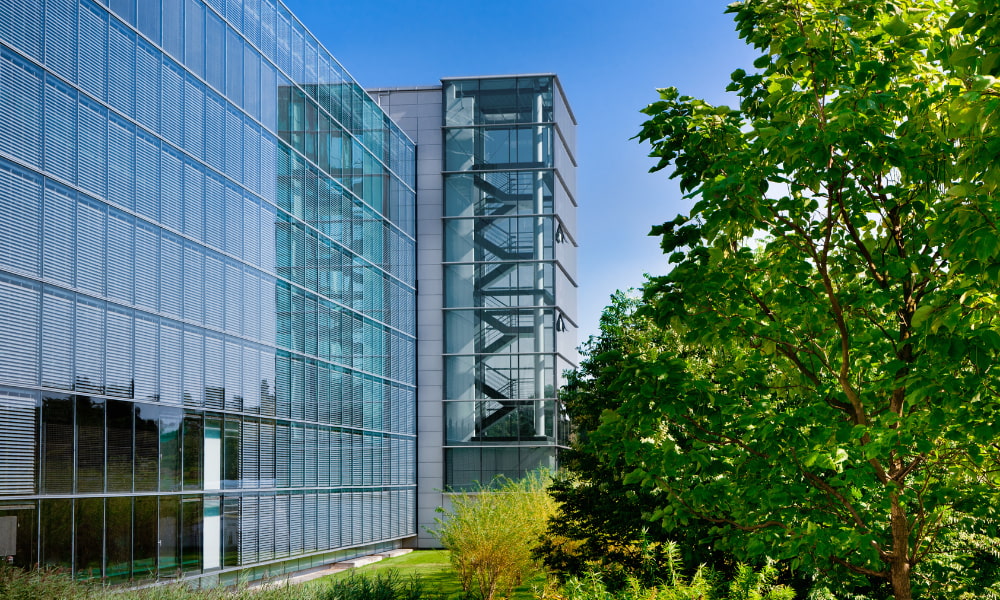Being an eco-friendly building isn’t just about recycling newspapers and aluminum cans. There are many ways to practice sustainability from the beginning of a construction project all the way through to its many years of occupancy, which is where green building certifications come in.
Green building standards set the tone for eco-conscious construction, efficient energy consumption, and more in both residential and commercial buildings ― and there are a lot of these certifications out there. The number is actually approaching 600 worldwide, and 100 options (and counting) in the United States. Some are directly related to new construction or renovations, while others relate to energy use, recycling programs within your facility, emissions, or water usage.
Here’s everything you need to know about green building certifications, including whether they actually have the impacts they’re designed to create.
What is a Green Building Certification?
First and foremost, it’s important to understand why these certifications exist. Many green building certifications come from governmental departments or national associations related to design and construction, and are designed to help builders and property owners both save money and be more eco-friendly. This includes:
- Offering clear guidelines and action steps that are required for certification.
- Committing to maintaining those green building standards.
- Recertifying buildings on a regular basis to ensure their ongoing commitment.
Getting certified as a green building helps you demonstrate that you’re serious about sustainability, something that matters to today’s tenants, property owners, and the community at large. Each building that is built with practices that earn such a certification is given a green building rating, a score that is monitored by a green building council.

This green building rating system compares the efficiency, environmental-friendliness, consumption, and other impacts of the construction and ongoing existence of the project.
4 Must-Know Green Building Certifications
Before you tout a green building certification, it’s important to understand what’s available and what each one requires or monitors in terms of eco-friendliness. These are four of the many green certifications available, and perhaps some of the most well-known in terms of tracking environmental quality and energy use in the U.S.:
LEED Certification
Brought to you by the U.S. Green Building Council, the Leadership in Energy and Environmental Design (LEED) rating designation is a highly recognized certification that started in 2000. The facts:
- It was founded on the belief that because we spend so much time in our indoor environment, those building should support our health and wellness.
- New and existing buildings, interior design, homes, and neighborhood development can all get LEED green certified.
- Projects earn points based on green initiatives, which vary depending on what type of building you have.
- For example: Distribution centers have different opportunities than schools.
The more points a project earns, the higher the LEED rating level it achieves, with Certified, Silver, Gold, or Platinum labels available on the LEED certification rating system.
Energy Star Certification
The U.S. Department of Energy and the U.S. Environmental Protection Agency (EPA) started Energy Star in 1992 to help save energy and utility costs plus protect the air and climate in residential and commercial interiors. Some things to keep in mind:
- You may have some Energy Star products in your residential buildings, including light bulbs, washers and dryers, computers, refrigerators, storm windows, and more for more sustainable building design.
- Products can earn the Energy Star energy efficiency label if they meet certain requirements for efficiency in an outdoor and indoor environment.
- Energy Star also works with builders and developers to create energy-efficient homes, office buildings, and more.
- The 20 largest home builders in the U.S. are Energy Star partners, for example, which means they consider the health and well-being of tenants as they create their projects with more sustainable practices than used in previous years.
Energy Star certified homes must be at least 10 percent more efficient than a home built to code, and more than 260,000 commercial properties used the Energy Star Portfolio Manager option to measure water use, energy efficiency, and waste materials in 2019.
The WELL Building Standard
Used in 65 countries, WELL v2 is the latest version of the WELL building standard from the International WELL Building Institute. A few facts:
- It touches on design of sustainable buildings as well as protocols and policies to encourage a culture of health and wellness within your organization.
- There are 10 concepts considered within the certification program, including air, water, nourishment, light, movement, thermal comfort, sound, materials, mind, and community.
- Each concept has an environmental impact as well as impacts building performance in both existing building parks and development projects.
There are certain preconditions that must be met to achieve the WELL v2 environmental certification. From there, projects can earn points toward one of four levels of certification in the certification process.
The GREENGUARD Standard
This certification focuses on indoor air quality in terms of building design and construction. Keep in mind that:
- UL’s air monitoring is a way to stay proactive about the air you and your tenants, employees, or customers breathe every day.
- The company can offer suggestions on how to improve your built environment and its existing HVAC system, ducting, and more to improve air quality as necessary.
This also increases productivity and reduces liability in terms of your environmental impact.
There are many other certifications available. The one you choose to pursue may depend upon your market and what’s important to local consumers, as well as how focused you are on environmental design or environmental impact over human health and energy efficiency (though the concepts work hand-in-hand). For example:
- A familiar name (like LEED or Energy Star) may be a good choice for some single-family and multi-family buildings or family homes.
- Some smaller, lesser-known organizations may offer a specific focus you’d like to pursue for your commercial or residential construction.
It may also be more practical to start with a different organization if it’s less expensive or demanding, then work your way up to achieving a designation with one that has higher standards and a bigger name.
Do Green Building Certifications Really Matter?
Yes, green building certifications matter. More people are looking for more sustainable lifestyles and these certifications help them do it. Tenants are also willing to pay for that opportunity to live or work in a building that cares about its energy and atmosphere or overall environmental impact.

Consider these facts:
- LEED alone certified more than 2,200 new projects in 2019.
- These buildings have been shown to pull in rents that are 10 percent above market value.
- LEED-certified buildings’ lease rates as high as 20 percent above average.
- At the same time, you (or your tenant) is paying up to 40 percent less for energy and water.
- Employee productivity in LEED buildings increases by up to 10 percent.
- Absenteeism drops by 35 percent.
These green building certifying organizations are on a growth trajectory. The existing ones are expanding their reach, new ones are frequently introducing themselves, and all are constantly innovating to find new ways to help their certified homes and businesses save money and protect the environment. With growing concern about air quality, energy consumption, fresh water, and the amount of waste materials or garbage filling our oceans, these certifications aren’t going anywhere.
What Green Building Certification Means For You
Whether you’re starting a new business, changing locations, or even re-opening your office following a pause in normal operations, it may be time to look into green building certifications for your space. If you’re a building owner, a green certification is a way to appeal to new tenants. If you’re leasing a commercial space, consider adding these to the list of must-haves for your location.
As your commercial real estate broker in Washington, D.C., The Genau Group can help you find eco-friendly buildings with green certifications. Contact us today to speak with an expert about any green building certification questions you might have.






